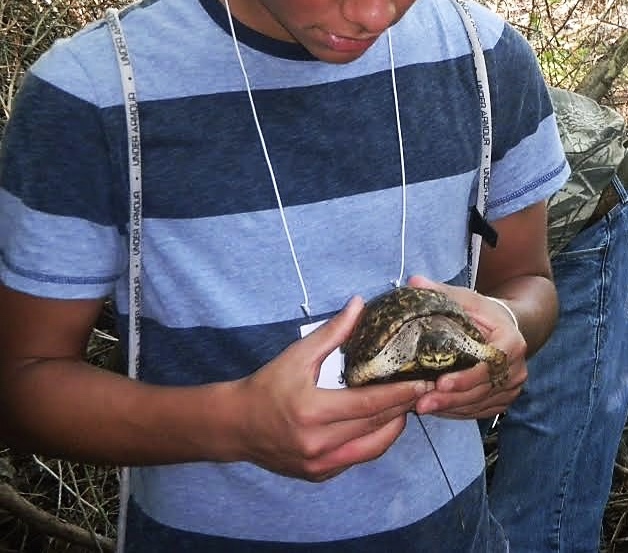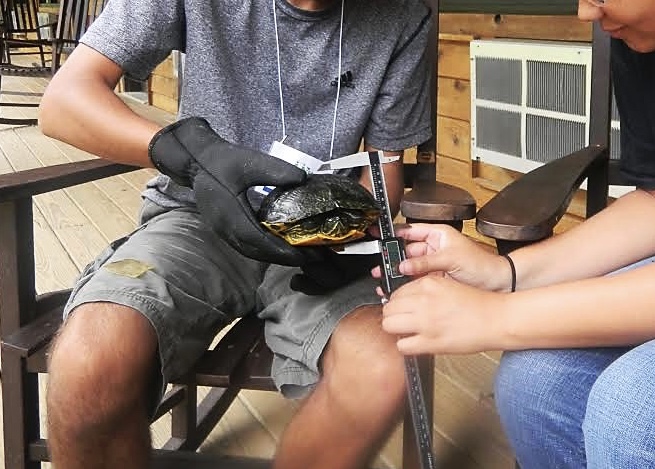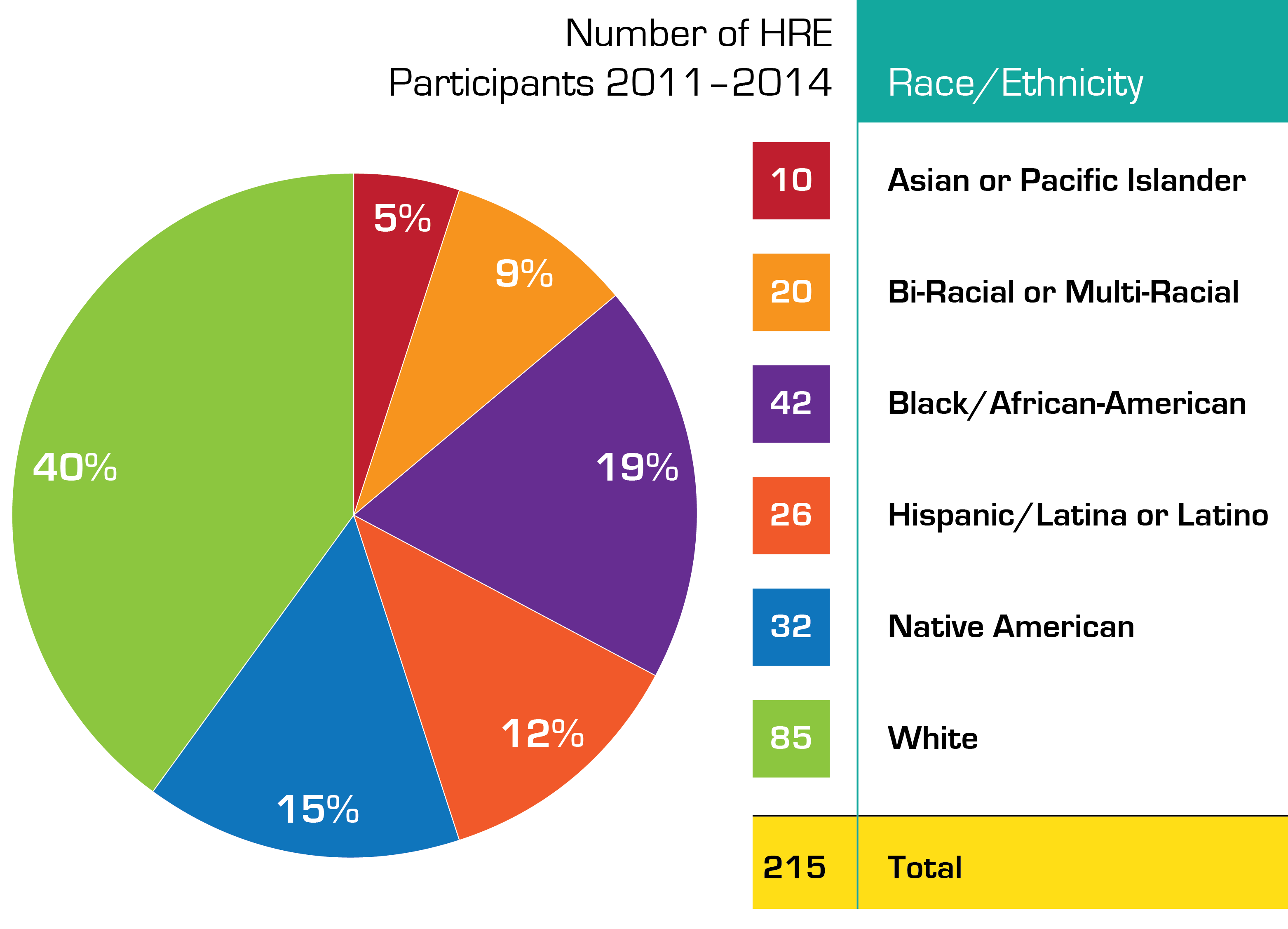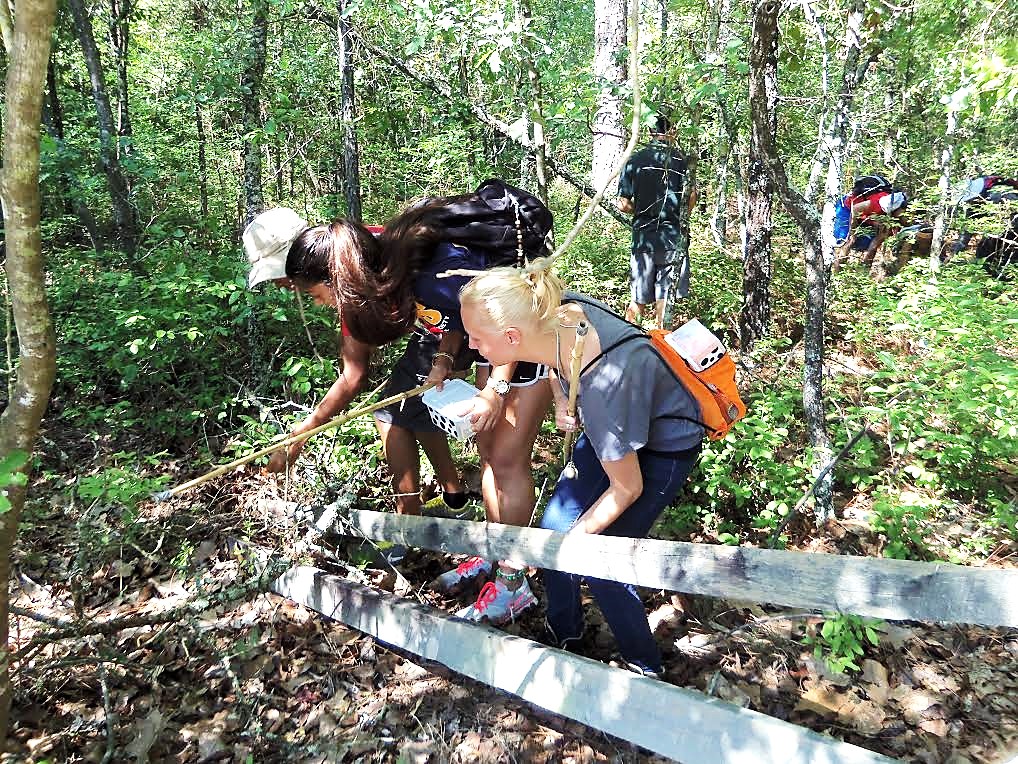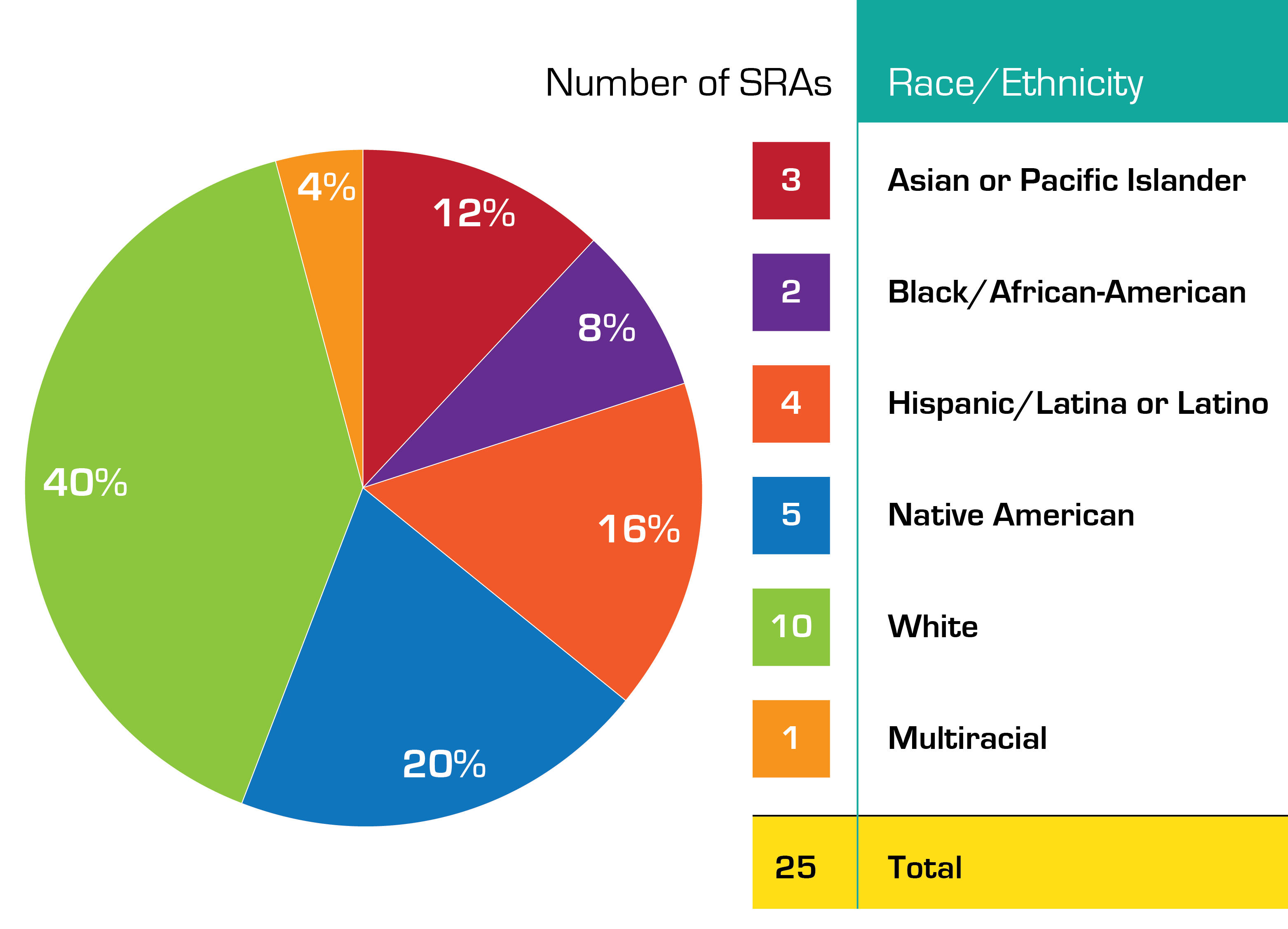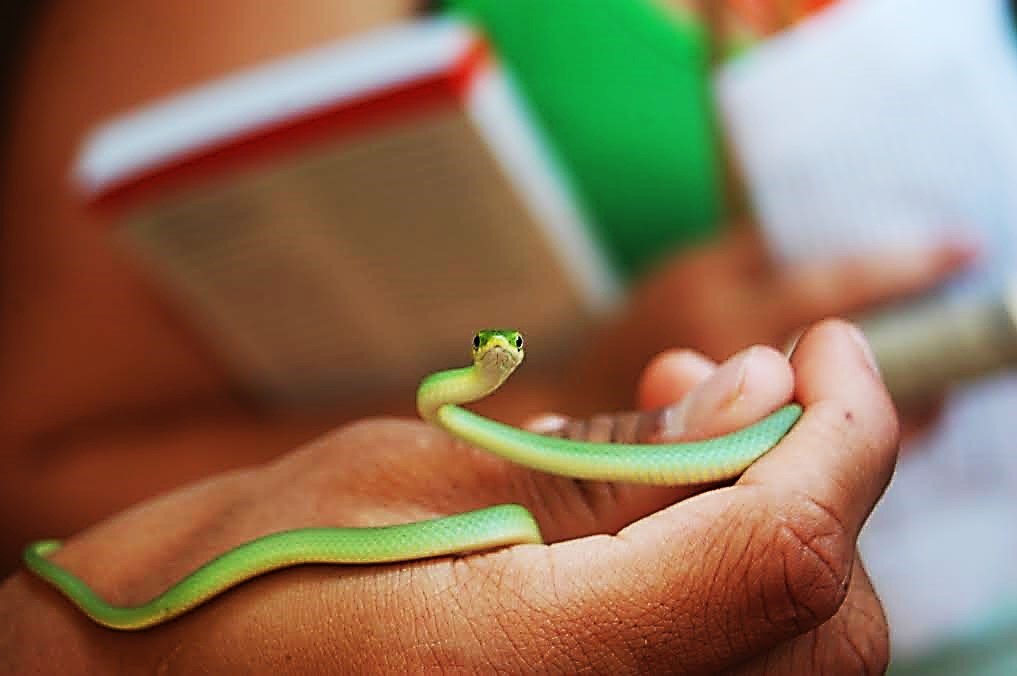Diversity and Equity
Promoting Equitable Access to STEM in a Summer Herpetology Fieldwork Program
Connected Science Learning November 2016-January 2017 (Volume 1, Issue 2)
By Aerin Benavides, Amy Germuth, Catherine E. Matthews, Heidi B. Carlone, Lacey Huffling, and Mary Ash
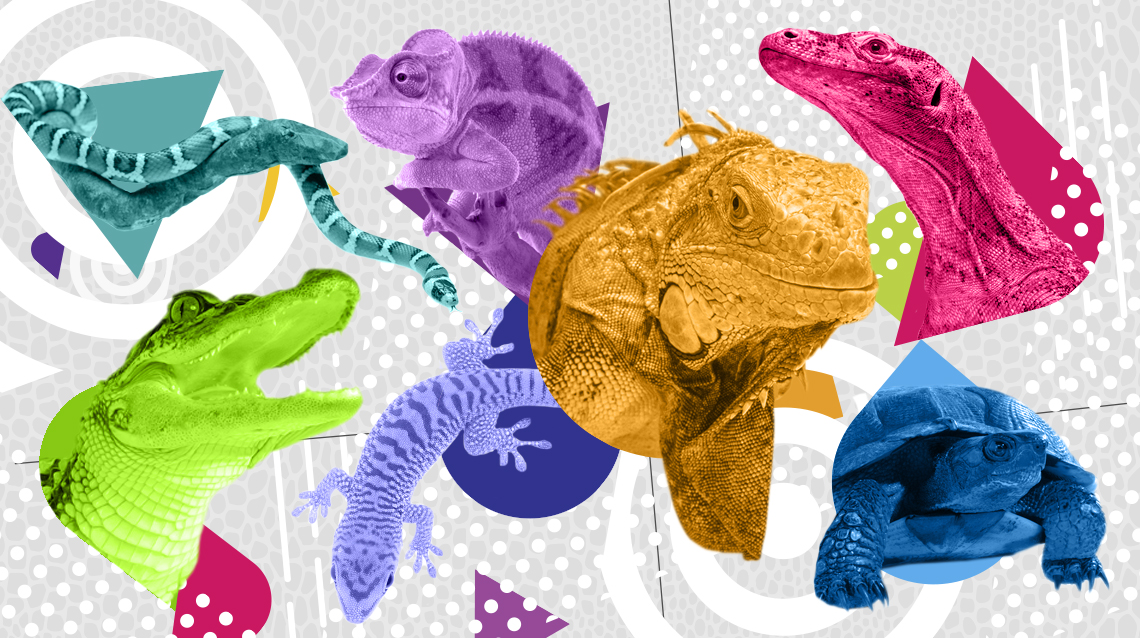
The HERP (Herpetology Education in Rural Places and Spaces) Project links in-school and out-of-school learning spaces by offering summer programs that engage high school students, scientists, and educators. The authors share the strategies they used to identify and serve a diverse set of participants.
The lack of equitable access to science learning for marginalized groups is now a significant concern in the science education community (Bell et al. 2009). In our commitment to addressing these concerns, we (the HERP Project staff) have spent four years exploring different ways to increase diverse student participation in our informal science programs called herpetology research experiences (HREs). We wanted the demographics of participants to mirror the racial, ethnic, cultural, linguistic, and socioeconomic demographics of the areas where our HREs are held. To achieve this, project staff worked closely with local teachers to attract and recruit diverse participants; thus, the connections between teachers in formal education and our informal learning program were paramount to our success. We defined diverse students as those from populations that are often marginalized in STEM education due to their gender, race or ethnicity, first language, socioeconomic status, academic status, and prior knowledge of reptiles and amphibians, as research indicates that these groups do not have equal access to STEM opportunities.
Nationally, enrollment in science classes by African American, Native American, Hispanic, and mixed race students lags far behind that of white students. Civil Rights Data Collection from 2010 to 2011 reveal that fewer than half of Native American students attend schools that offer a full complement of mathematics and science classes. In comparison, 81% of Asian American students and 71% of white students attend high schools where upper-level math and sciences are available. Equal access to formal science and mathematics education for all students is clearly lacking (NSB 2016).
Lee and Luykx (2010) argue that students of all backgrounds should have challenging science learning opportunities that permit them to explore and construct meanings based upon their own linguistic and cultural experiences. But lack of access to quality STEM education can be a problem even when efforts are made to include diverse students. In a recent initiative to address the diversity problem, students from varying backgrounds and academic achievement levels were accepted into a STEM-focused school in the United States; however, their teachers lacked the support needed to create STEM-focused projects that would promote buy-in from diverse students (Slavit, Nelson, and Lesseig 2016). In addition to enrollment and access issues, there is a STEM achievement gap among students with less access to STEM learning. In 2016 the National Science Board’s Science and Engineering Indicators report concluded that black, Hispanic, and Native American eighth graders scored much lower than their white and Asian counterparts. Students from low-income families scored substantially lower than peers from higher socioeconomic backgrounds. Students from homes where English was not the primary language scored much lower than students from homes where English was the primary language.
Like the other STEM fields, herpetology (the study of amphibians and reptiles) also lacks representation of marginalized cultural groups and women, and has historically been dominated by white men (Wilson 1998). A recent membership survey conducted by the American Society of Ichthyologists and Herpetologists (ASIH) revealed that its membership was 70% male, 94% white, 92% non-Hispanic, and 4% Asian. African Americans, Native Americans, and Pacific Islanders each represented less than 1% of the total membership (Prosanta Chakrabarty, personal communication). Similarly, the North Carolina Herpetological Society (NCHS) currently has a “mostly White” membership that is approximately 60% male (Ann Somers, personal communication). Concerned with this lack of diversity in STEM and herpetology, over the last decade some of us at the HERP Project built bridges between informal science learning venues and local public schools as part of an effort to make STEM learning accessible to all. These vital connections have allowed us the privilege of introducing a diverse population of young people to the science of herpetology, including students of different genders, races and ethnicities, economic statuses, academic statuses, communities (urban, suburban, rural), and those with varying first languages and prior experience in STEM.
The HERP Project
We, the HERP Project team, are a group of scientists, professors, teachers, and college students who are dedicated to herpetology education and conservation. We believe and recognize that science interest and talent reside in all students. We also recognize that the natural world is facing critical global ecological challenges (Kelly 2014). This is why we developed the HERP Project, which is specifically designed to provide citizens with increased access to herpetology and conservation education in three regions of North Carolina: the eastern Piedmont, the central Piedmont, and the Inner Coastal Plain. As one of our major endeavors, we offered summer Herpetological Research Experiences (HREs) to diverse high school participants. HREs were summer residential science fieldwork experiences for rising 9th through 12th graders; the program has been modified to be sustained by environmental centers and summer camps in North Carolina and Georgia. HRE staff aimed to cultivate students’ interest in, engagement with, and curiosity about reptiles and amphibians so they might see themselves as legitimate participants in and contributors to science. Two of the HRE programs were one week long and held at a summer camp’s facilities. The third HRE was four weeks long and part of a college access program at a local university; high school students accepted into the college access program selected the HRE as a course option for the monthlong program. As part of all three HREs, high school students participated in six field studies on reptiles and amphibians and their habitats1. Participants collected data (e.g., species identification, measurements, and photos) and uploaded results to citizen science databases such as the Carolina HERP Atlas2.
During the evenings of the two weeklong HREs, participants engaged in activities including making jewelry from snake vertebrae and dissecting previously deceased turtles and snakes collected from local roads. Participants also learned to distinguish between the calls of different frog and toad species. This skill helped them document the presence of different frog and toad species during night hikes. Also during the weeklong HREs, students engaged in a variety of traditional camp activities such as swimming, boating, games, and ropes courses in the afternoons. The monthlong HRE had a greater academic focus because it was part of a broader college access program. Participants in this program spent their evenings studying or engaging in college preparation experiences. The HERP Project offered students from all HREs opportunities to engage in herpetological fieldwork during the following school year. These opportunities included trips to the coast to observe sea turtles, trips to mountains and ephemeral pools to study salamanders, and public education events where participants taught herpetology to the public3.
The HREs prompted youths’ learning and curiosity about reptiles and amphibians (herps), which surprised those with limited prior experiences with and/or fears about herps. For example, during an interview that was part of the research conducted at the HREs, one participant, Jaylyn, said:
Jaylyn: “It [the HRE] was really different because of how you handle objects and animals. Just totally different from the way we were taught. We were taught to avoid them, and here you get to experience them and handle them.”
Interviewer: “Okay. So what did you learn about yourself during this experience?
Jaylyn: “That I like science even more than I thought I would, and that I was even more curious and outgoing than I thought I was.”
As indicated by Jaylyn above, reptiles and amphibians (herps) have often been maligned as slimy, nasty, aggressive creatures to be avoided. In contrast, we believe that enhancing diverse high school students’ knowledge of herpetology and herpetological field science can help prepare them to pursue STEM careers. Hiller and Kitsantas (2014) reported that diverse high school students who interacted with experts in field science increased their scientific observation skills and their interest in pursuing STEM careers. We also believe that students will become advocates for herps as they learn the vital ecological role that reptiles and amphibians have in their local ecosystems. Daniel, another HERP Project participant, stated:
“We’re facing almost an extinction crisis with amphibians worldwide. And they, I think, are very good indicators of the health of our ecosystems. And since they’re declining, that means our world is declining. And I think that’s … because they contribute a whole lot to our biodiversity. North Carolina, especially, this is kind of what we’re known for is having lots of reptiles and amphibians.”
The Connection: High Schools to Summer Science and Summer Science to High Schools
To match the demographics of our county in the HRE groups, we reached out to teachers at local public schools with minority populations to find underrepresented students who were interested in participating in HREs, which were free of cost to all participants. We worked with teachers we knew through our prior work in schools, teachers who had supervised our university student teachers, and teachers who were interested in outdoor science education. Our recruitment efforts also included direct outreach to schools. We took newts to high school biology classes to teach students about the organism’s natural history. In another classroom, students were fascinated by our American toad responding to the recorded call of another toad. In these classrooms we helped students measure and weigh the herps while explaining the importance of reliability and precision of data collection. We also gave in-class presentations with animals, which we felt made teachers more willing to recruit students for the HREs, as they became familiar with the animals and the curriculum. Because many students we targeted for the program did not have internet access at home, their families were unable to e-mail the applications or fill out the online application forms for the camps where youth would be housed, so their teachers were incredibly helpful in encouraging them to bring in signed hard copy forms. Some teachers had to coach students on how to fill out the application form and check in with them multiple times until their parents signed the forms. Teachers also wrote recommendation letters for the students and mailed them with the application forms.
Because we depended on teachers to help us reach the diverse students we were targeting for our program, we offered the teachers opportunities to lead groups of students during the HREs. The teachers knew their students and their students’ backgrounds well and were supportive as group leaders in ways we could not have predicted. For example, they instinctively knew the importance of taking many photos during fieldwork. They elicited smiles by hamming it up at times and knew to capture on camera the exciting moments when students made their first discoveries in the field. We also worked to select teachers who reflected the backgrounds of the students we served. For example, in the area where we worked with Lumbee Native Americans, we recruited teachers who are also Lumbee.
Along with the student participants, teachers rotated through the six different field studies during our weeklong summer HREs. We paid teachers a stipend to participate and offered them free room and board. This rotation helped the teachers understand the focus of a particular field study and to become familiar with the research tools used. Teachers could also apply to be assistant project leaders. As assistant project leaders they were directly involved in setting up the field research studies and facilitating the participants’ observations and data collection. Teachers often moved along a trajectory of expertise, and by their third year participating in HREs, they were eligible to become studies project leaders. Teachers worked with us for up to two, three, or all four years of our program, sharing their experiences with their students during the school year.
In addition to the recruiting done by the teachers we worked with, we recruited students in our target demographics by handing out application forms and explaining them in person at multiple public events, such as a street fair at the state museum of natural science. We worked with the local museum of science to recruit youth from their junior curator program, some of whom were female and/or of mixed race. We worked closely with HERP Project university professors and staff familiar with their local Native American community and worked with the Office of Indian Education to identify and recruit Native American applicants. For our four-week HRE classes, we preselected youth whose parents had not attended college. We offered the herpetology course to all participants at the college access summer program, and 16–18 students took the HRE course each summer it was offered. We also made application forms available online via our website. We depended upon various groups of people, various methods, and various organizations to help us recruit this targeted population.
Diversity in the HERP Project
Participants in the HERP Project’s HREs were diverse in gender, race and ethnicity, first language, socioeconomic status, academic status, and prior experiences with nature or animals, according to interest surveys and their application forms.
Each summer we offered the HRE, we conducted a research study that examined youths’ meaning-making and identity work (i.e., their knowledge, engagement, recognition of self, and recognition by others as a science person) (Ash, Carlone, and Matthews 2015; Carlone et al. 2016; Carlone et al. 2015). All HRE attendees were offered the opportunity to participate in the study; only 13 youth declined the opportunity. Data were collected from all study participants (N = 202) via self-report on application forms and essays, surveys about scientific interests and identities before and after the HRE, knowledge assessments before and after the HRE, exit interviews, and follow-up surveys with parents/guardians (23% response rate). Interest and identity surveys, interviews, and assessments were designed by the HERP Project education research team, with input from EvalWorks, an independent evaluator. Follow-up surveys were administered by EvalWorks. Over the four years since the HERP Project began, 215 participants attended HREs; 51.4% of them were female and 48.6% were male. Fifteen percent of HRE participants reported Cs in their most recent science course. Almost two-thirds (60%) of all participants identified as African American, Hispanic, Native American, Asian or Pacific Islander, or multiracial, in contrast to 40% who identified as white (see Figure 3).
The HERP Project also included students from other marginalized segments of the population, such as individuals from rural backgrounds and students with low academic performance (i.e., students who scored low on science, mathematics, or literacy assessments) who were interested in science. Important considerations when reviewing applications included establishing an even gender ratio and creating small groups of five or six students in a similar age range with a mix of races and ethnicities, socioeconomic statuses, academic level, and science and herpetology experience.
Participants revealed the following information about themselves on applications and pre-surveys: 62% had never attended a special science program, such as a science camp, and none had ever received an award for science work. While 92% of our participants believed that science was interesting, only 80% believed that they were “good at science.” Even fewer participants (66%) believed that they could be good scientists, and fewer than half (49%) believed that they “thought like a scientist.” Participants’ pre- and post-knowledge assessments showed that their knowledge about herps, herpetology, and herpetological fieldwork increased, on average, by 20%. Additionally, post-participation surveys revealed that participants’ interest in science, the personal importance they afforded science, and their beliefs that they were good at science, thought like a scientist, and could be a good scientist, increased by an average of 0.6 points on a scale of 1 to 5.
Strategies We Employed
The HERP Project staff took multiple steps to engage underrepresented students in the HREs. The one-week HREs were designed to be residential programs held at summer camps, and participants were required to stay overnight in cabins with same-sex and similar-age participants and were supervised by camp staff when not participating in HRE activities. We found that sleepovers were less common for Hispanic and Native American students than for white students. For example, many of the Lumbee Native American participants had never spent nights away from home except with relatives. Project staff and our local contacts who were supportive of the HREs reached out to families who were reluctant to have their child spend nights away from home. We helped families understand the level of supervision we and the camp staff provided for participants. In some cases, the local contact or project staff met with Native American or new immigrant families and guaranteed that they would personally watch over their child at the HRE. In one instance, a staff member sent daily photographs of a young male participant to his mother. Without the assurance of daily photographs, the mother would not have let him attend the HRE, as the camp administrators did not allow campers to have cell phones or call home.
Figure 4 provides additional information about our outreach to teachers, participants, and participants’ families. Table 2 also lists our efforts to promote equitable access to and engagement in our HREs, which we discuss in the next section.
Figure 4
HERP Project Outreach and Efforts to Provide Accessibility to the HRE Program
| Outreach to Students and Families | Efforts to Promote Accessibility |
|---|---|
| Sought relationships with teachers who taught at schools with large diverse populations | Sought to establish same racial/ethnic percentages at the HRE to match the demographics of the county in which the HRE was held |
| Recruited at community events by handing out application forms to youth and their families and explaining the HRE to them in person | Identified locations with diverse populations that could accommodate the HREs |
| Notified schools and community stakeholders about the HRE opportunities (e.g., the Office of Indian Education, scout groups, churches) | Based acceptance on the marginalized groups to which participants belonged (vs. accepting on a first come/first served basis) |
| Recruited staff with similar backgrounds to students in targeted demographics and who lived in the same communities as those students to help with recruiting efforts | Provided supplies and support for students who couldn’t afford them (e.g., transportation, clothing, gear, sleeping bags, sunscreen) |
| Used multiple avenues to communicate with families (e-mail, calls, mail, in-person visits) | Hired interpreters for hearing-impaired students and nish-speaking staff who could communicate with parents when necessary |
Accessibility in the HERP Project
As science and environmental educators, we recognized that simply having diverse participants in our program did not ensure equitable access. There are many barriers to individual participation in science, many that involve family resources and engagement (Evans et al. 2005). Thus, we provided additional support to participants and parents or guardians. For example, bilingual staff members communicated with Spanish-speaking families when necessary by contacting them via phone, and all documents were translated and available in Spanish. Because the camps we worked with required paperwork that could only be completed online, we called families who didn’t have internet access and completed the forms with them over the phone.
We also ensured that all HRE participants would be prepared for fieldwork, since most HRE activities took place outdoors. Mosquitos, chiggers, and ticks thrive in the hot and humid North Carolina summers, and participants needed to hike through thick forests and along creek banks where these pests were abundant. We provided both transportation and supplies (e.g., water bottles, insect repellant, field pants, boots, sunscreen) for all participants whose families were unable to provide them. By providing participants in need with the necessary materials, we ensured that everyone could fully engage in the HRE activities.
In addition to successful recruitment of diverse students, we knew our curriculum and teaching styles needed to be accessible to all program participants. Pedagogical strategies included:
- Presorting participants into small, diverse groups that explored and learned together throughout the week. The small-group configuration provided a supportive, family-like group for participants, which encouraged their risk-taking and safe exploration of unfamiliar environments and activities. The diversity of the groups prompted nurturing and empathy among group members. Nearly every group member was put into a new or uncomfortable situation at one point or another, and nearly every group member was able to help others learn more, overcome fears, or just lend a helping hand.
- Recognizing and valuing the different experiences and knowledge participants brought with them and tailoring our curriculum to work within that context.
- Sharing preliminary research findings with staff so they could recognize and learn to leverage youths’ funds of knowledge (i.e., the knowledge, experiences, and resources youth brought with them). Funds of knowledge might include nontraditional types of science knowledge (e.g., hunting, fishing, gardening, nature experiences, animal husbandry), which we recognized as valuable and legitimate. For example, many of the Lumbee male participants were hunters, familiar with animal tracking, exploring the outdoors, and trekking safely and respectfully “off-trail.” Some of the Lumbee youth were outstanding leaders for the box turtle population studies, where their funds of knowledge were important elements of the activity and allowed them to get recognized by their peers as important contributors.
When organizing participants into groups that worked together for the duration of the program, we avoided isolating any student by race or ethnicity (i.e., there were at least two students belonging to a single race or ethnicity in every group). We also put students in groups with participants who were not friends or who were from different schools because we wanted to encourage them to socialize with people they did not know. We also ensured that each group’s members had varying levels of prior experience with nature and animals. Finally, we organized groups by grade level to help rising ninth graders avoid feeling intimidated by older students.
Regardless of expertise or grade level, HERP Project staff members valued participants’ different levels of knowledge. We encouraged group members to share their experiences with one another while conducting fieldwork. Additionally, we asked the small groups to present their research findings to the HRE at appropriate times.
Engaging Students Through Leadership Opportunities
Many HRE participants wanted to return the following year to repeat the program, but we did not have enough resources to support an advanced course for returning participants. Instead, we developed the Student Research Assistant (SRA) program for participants who were eager to attend an HRE the following year. These returning participants assisted the project leaders with collecting herps and helped new participants learn about the animals. Although we were unable to accept all applicants for SRA positions, we endeavored to be as equitable as possible in our choices. We strove to choose as many girls as boys. Additionally, we aimed to mirror the demographics of participants with the SRAs.
To familiarize themselves with the project for which they would serve as assistants, SRAs arrived earlier than other HRE participants. SRAs hiked the fieldwork areas to become familiar with the sites, led introductory hikes the first day for new participants, and used their prior experience to help new participants find organisms to observe during night hikes. As scientists and educators who use inquiry-based instruction, we asked SRAs to be facilitators rather than lecturers and to encourage participants’ questions. We also instructed SRAs to ask new participants questions about what they were observing.
Over the life of the HERP Project (2011–2014), 23 students (12 female and 11 male) returned for a second year (and two returned for an additional third year: one female, one male) as SRAs. As shown in Figure 6, multiple races and ethnicities were reflected in the SRA group such that students who identified as African American, Asian or Pacific Islander, Hispanic, Native American, or multiracial represented 60% of all SRAs.4 To encourage past participants to apply to be SRAs, we identified those who had been most engaged during the summer and had participated in at least one of the follow-up events during the academic year. From this pool of participants, we personally e-mailed and called students to encourage them to apply to be SRAs if they had not already done so. As one African American male participant stated in an interview, “Getting a phone call from a professor telling me that she thought I’d be a good SRA made me realize that I could do this. I still can’t believe that y’all took the time to call me, but I’m so glad you did.”
Results
After completing the HRE program, participants reported learning to appreciate the herps they studied. They enjoyed finding them, holding them, taking selfies with them, and talking to them. Some of our high school students, generally those with less experience with herps, definitely had a change of heart about herps, as indicated by Laneesha and Jervey.
“At home, like if you see a snake, in the country, you put mothballs around your house because we don’t like snakes. We try to stay away from snakes, and if we do see a snake, we kill it. And like, it’s different from when you’re here because if you see a snake, you run towards it and you try to catch it. You try to identify what type it is and you take it to someone [to identify it].”
“And like a [dead] snake [on the road] is roadkill. If you’re at home, you just say, “Ew, that’s nasty.” If you’re here, you bring it [in] so you can dissect it, and then like pull its fat out, and its intestines, and look at everything. And so, there’s a big difference, and those are things that I’ve experienced that are like totally different because in one environment, you run away from snakes. You kill snakes. You—you’re disgusted by snakes. But in another place, you love snakes. You admire them. They’re your friends, and you love them.”
The personal transformations of young people, which certainly occurred over the weeklong or monthlong residential programs, were remarkably different over the span of one, two, three, or four years. Students matured, but they also built deep, engaging, ongoing relationships with each other and our staff. One participant rarely spoke during his first summer. The next summer, he returned as an SRA and was an excellent studies coleader. In his third summer, he not only co-led a study but also had suggestions for the overall program.
Another student was a typical ninth grader when he first started, engaging in typical school antics (such as throwing papers or making strange comments), but as the week progressed, he became increasingly engaged in the projects. He needed transportation to attend, and on his three-hour ride back home, he questioned the project staff about how he could continue to learn about herpetology. Throughout the academic year, he attended all six follow-up experiences and was the first to submit an application to come back as an SRA the next summer. In his second year, he was an outstanding SRA. He returned as a second-year SRA, and eventually served as an assistant project leader in his third year. Another young woman had almost nothing to say her first year, but we could tell from her deep engagement that she enjoyed the HRE activities. She came back as an SRA the following year and even did a short television spot with our staff.
Program Challenge
Throughout the program’s lifespan, we have spent considerable time and effort achieving our goal to provide equitable access to meaningful science education for diverse participants. However, we realized during the first HRE that most of the herpetologists who visited and worked with our students were white males. Additionally, many of the HERP Project staff members, including our graduate students, were also white and middle class, which unfortunately reflects STEM fields nationwide. Many of the counselors provided by the camp administrators were also white and middle class (however, camp staff hiring choices were beyond our control). We attempted to make up for the lack of diversity in the HERP Project staff, the vast majority of whom were white, by asking diverse HRE teachers, such as Native American teachers, to take on a central role within the program.
Best Practices for Increasing Equal Access to Informal STEM Projects
Our experiences designing the HREs lead us to suggest the following best practices for programs trying to make informal STEM education accessible to marginalized students.
- Partner with a wide variety of science educators and professionals.
We began building our HRE program by partnering with scientists and university educators, and later expanding to include herpetologists, summer camp personnel, graduate and undergraduate students (many of them science or education majors working in K–12 classrooms), and K–12 teachers and administrators. Partnering with these people, especially the teachers, allowed us to reach a broader group of potential applicants for the HRE program and to reach those who are underserved by informal science education programs.
- Recruit diverse participants and team members.
Consider diversity from multiple perspectives (gender, race or ethnicity, socioeconomic background, academic background, level of science knowledge, and past experience with herps and being outdoors) and make every effort to recruit students and teachers who reflect this diversity. In the HRE program, this strategy served to give marginalized students access to an informal STEM education opportunity that they might not have had otherwise, led by a team of teachers who belonged to the same diverse groups and could best understand the participants’ needs.
- Connect with teachers.
Connecting with teachers was especially helpful in reaching students we might have otherwise overlooked or who might not have applied to the HREs. Taking herps to classrooms wasn’t just a great way to spark students’ interest in HREs; it also gave teachers an opportunity to learn more about these organisms and scientific fieldwork. Many teachers who worked with us in reaching students also became involved with the HREs, first as observers and then as leaders. We found that the learning opportunities that evolved through their connections to the HERP Project were beneficial to all involved. These opportunities included learning how to enact ecological fieldwork with their own students, which unexpectedly prompted further personal initiatives such as leading a project at a subsequent HRE or adopting a disabled box turtle as a class pet.
- Connect with area organizations.
We connect with area schools when teachers learn our curriculum and do fieldwork from the HREs in their classrooms. All educators have access to our curriculum because we share it with the public online. Access to the HERP Project HREs was free of cost to all participants, and this, while key to recruiting diverse youth, was not the only mechanism to facilitate universal access to STEM. We put extensive and exhaustive effort into recruiting and sustaining targeted marginalized participants, often with support from organizations such as the Office of Indian Education and the local science museums. Although the grant funding expired, HRE staff at one of the summer camps and a local science museum are using our HERP Project HRE curriculum to continue summer herpetology programs, and they offer scholarships. We have also offered them some support by sharing our contacts and experiences with the recruiting of staff and students.
Conclusion
When Nate, an SRA, was asked what his best experience during the HRE was, he responded:
“I think Ishmael picking up the snake has gotta be it because that was just—it was such an amazing transformation—within two hours, he was going from terrified of them, not even wanting to go out into the field or be anywhere near them, to holding them and appreciating them for what they are.”
As Nate’s response demonstrates, student success and engagement, such as Ishmael’s, are highlights for most educators, and informal science learning environments such as the HERP Project’s HREs provide unique opportunities for students. Therefore, it is imperative for formal and informal educators to work together to provide access to STEM programs for students who are marginalized, and it is through strong partnerships that we move toward a more equitable learning experience for all students.
Acknowledgments
The authors of this paper acknowledge the contributions of all HERP Project Principal Investigators (Andy Ash, Heidi Carlone, Catherine E. Matthews, Ann Somers, and Terry Tomasek); North Carolina Department of Natural Resources (Jeff Hall); and the many, many K–12 students, undergraduate and graduate students, and K–12 teachers involved in this project. This work was supported by the National Science Foundation grant #DRL-1114558. Any opinions, findings, and conclusions or recommendations expressed in this material are those of the authors and do not necessarily reflect the views of the National Science Foundation.
Aerin Benavides (awbenavi@uncg.edu) is a postdoctoral fellow in the Department of Teacher Education and Development at the University of North Carolina at Greensboro in Greensboro, North Carolina. Amy Germuth (agermuth@gmail.com) is a program evaluator and owner of EvalWorks, LLC, in Durham, North Carolina. Catherine E. Matthews (cematthe@uncg.edu) is professor emerita in the Department of Teacher Education and Higher Education at the University of North Carolina at Greensboro in Greensboro, North Carolina. Heidi B. Carlone (hbcarlon@uncg.edu) is professor of science education in the Department of Teacher Education and Development at the University of North Carolina at Greensboro in Greensboro, North Carolina. Lacey Huffling (lhuffling@georgiasouthern.edu) is an assistant professor of curriculum and instruction in the Department of Teaching and Learning at Georgia Southern University in Statesboro, Georgia. Mary Ash (mary.ash@uncp.edu) is coordinator of undergraduate science education in the Department of Biology at the University of North Carolina at Pembroke in Pembroke, North Carolina.
1 More information about the studies is included on the HERP Project’s website. The HERP Project Curriculum for teachers and informal educators, which aligns with the Next Generation Science Standards, is also available for free.
2 More information about the Carolina HERP Atlas is available online. The HERP Project also highly recommends the HERPMapper and has started to upload data to this international database.
3 UNC-TV Produced a six-minute special on box turtles, which features students and our staff. This show is still shown regularly on public TV. The HERP Project’s Video entry for the 2016 NSF STEM for All Video Showcase highlights our former participants working with the public at UNCG’s second Science Festival.



